Martin Scorsese calls Robert Wise’s ’63 haunted house movie, The Haunting, the scariest movie of all time. Though it didn’t make too big a splash when it came out, it’s since risen higher and higher in estimation, and is often cited as one of the best horror films ever made, despite not containing anything horrific, and only being scary insofar as you find loud noises and people cowering in ornate mansions scary. Upon viewing The Haunting, I find I do not.
The Haunting is one of those movies I always assumed I’d seen, or at least pretended I had, without ever having seen it, despite its having set the stage for all subsequent haunted house movies, of which I’ve seen plenty, and, along with the novel it’s based on, Shirley Jackson’s The Haunting of Hill House, having inspired Stephen King’s The Shining. The time had come to check it out. Which I did.
The result? Not scared. And I like old horror movies. Even if they’re not quite as terrifying now as they would have been when they came out, I’m all about watching Val Lewton flicks, or the old Universal monster movies, or, best of all, science fiction giant bug movies. They’re fun. The Haunting isn’t fun. It’s very, very serious. On top of that, it doesn’t make a damn lick of sense.
But before we get to all the silliness, let’s discuss the positive: the movie looks fantastic. It’s shot in exceptionally creepy black and white, and taking place as it does in an old, ornate mansion, with unusual angles and deep focus, it calls to mind Citizen Kane (on which movie Wise was an editor; he also edited and shot extra scenes for Welles’s The Magnificent Ambersons). Wise wheedled a new, not yet perfected 30mm lens from Panavison, which he and cinematographer Davis Boulton used to shoot weirdly wide-angle close-ups. They used all sorts of strange effects, sending the camera flying at walls and doorways, up and down rickety stairways, and so on. Sam Raimi lifted a bunch of these ideas—and used them to extreme and comic effect—in Evil Dead II (which if I’d ever watched The Haunting before, I’d have known that. Movies are so educational). The exterior of the giant scary mansion was shot using infra-red film, which in black and white gives it a bleak, sharp look.
Beyond that, the style of the movie is meant to keep viewers off-kilter. It’s impossible to mentally map out the house. One is never sure where any one room is in relation to any other. Windows are seldom seen, so whether it’s night or day is rarely known. It’s a smart tactic. Is it scary? Unnerving? For me, not so much. More like intellectually noteworthy, as opposed to emotionally affecting.
The eeriest effect in the movie is when a seemingly very solid, very wooden door, bulges inward with the pressure, one presumes, of some deadly spirit on the other side. It’s the kind of effect that’s been used to death since, but here it’s impressively wrong to see that door bulge in that way.
What about the story? The story, i.e. the silly part, is that a scientist, Dr. Markway (Richard Johnson), who believes in the supernatural, but has no proof, wants to spend a week in this famous haunted house to see if he can prove the existence of ghosts. He’s going to bring along an assortment of carefully selected assistants, or so he tells the owner of the house in order to impress her.
Only it turns out that “carefully selected assistants” means not other scientists, but people Markway has read about who’ve had supernatural experiences. Or something. In any case, only two of like eight such assistants actually show up. One is a noted psychic, Theodora (Claire Bloom), and the other is the mentally unstable, histrionic Eleanor (Julie Harris), whose inner thoughts we sometimes hear, always accompanied by eerie music. Her claim to supernatural fame? When she was a kid, stones rained down on her house. Or so say news reports. She denies it.
Sounds like the perfect research assistants to me! Although since Markway isn’t seen doing any scientic research of any kind during the movie, maybe they’re perfect after all. Also present, the nephew of the lady who owns the house, Luke (Russ Tamblyn, who’d just worked with Wise on West Side Story, and who no matter his age I will always know as Dr. Jacoby from Twin Peaks). He is a smug, rich playboy, whose every remark is smarmier than the last.
What does their research consist of, these four paragons of scientific inquiry? Nothing. Literally, not a damn thing. What happens is that they go to sleep, and then scary thumping noises start up, and the ladies are terrified, and the fellas come running, eventually, not having heard anything. No research is done. When the crazy noises occur, nobody ever leaves the room to, I don’t know, investigate them. They just stand there terrified.
Markway says over and over again that ghosts have never harmed anyone; they are merely visions. Nothing to be afraid of! Only, as above, he never once actually attempts to follow one, find one, interact with one. You’d think he’d at least have a camera. A test tube. An abacus? Anything. I think he takes some notes in one scene. Then again, he might just be drawing pictures of bunnies.
Late in the movie, after essentially nothing at all has happened, aside from a fair bit of yelling and the suggestion that Theodora is a lesbian (she’s jealous of Eleanor’s flirting with Markway and wants to share her bed with Eleanor—you know, for safety), Markway’s wife, Grace (Lois Maxwell), shows up. Wife? Eleanor is devastated. Markway thinks the house is much too scary for Grace, but she wants to stay anyway. She even wants to sleep, not with Markway, but in the—
NURSERY ROOM!
Sorry, the nursery is where the little girl whose mother died mysteriously way back when shuts herself up in until she grows old and dies. It’s clearly the hauntediest room in the house. Outside its locked doors is a strange “cold spot” where our heroes’ breath comes out icy. But when Grace shows up? The nursery doors are open! Inviting her in, you might say. Cue music.
Then what? Oh, gosh, Grace disappears, don’t you know, winds up in the attic (“I was trying to get out of the house, but I got lost,” and you wound up in the attic? Really?) and scares the bejeebus out of Eleanor, who tries to drive away, but on the windy (curvy, that is) driveway there’s Grace again, all fright-faced and benightgowned, and Eleanor—well, I can’t give it all away, can I?
Apparently writer Nelson Gidding though the book was about the psychological breakdown of Eleanor, but in a meeting with Shirley Jackson was told no, it’s ghosts. The movie, as a result, is schizophrenic on the matter. It feels like maybe it wants everything to be in Eleanor’s head, while being quite clear that these weird things are really happening. Everyone experiences them. So which is it? Ghosts or crazy-time? A little of both. Eleanor is unhinged and thinks scary things are around every corner—and also, there are ghosts around every corner.
The Haunting is not scary. If you tell me people wet their pants back in ’63, I’ll accept it. The movie is made with a lot of skill and creativity, using then-innovative editing and shooting techniques, so it’s not surprising people were freaked out. Some people. Again, it didn’t do well upon its initial release. But now? I’m just not seeing the scares. I found much of the movie boring. The characters are ridiculous. The story is, in a word, absent. The Haunting is an exercise in style made by very talented and clever filmmakers. Impressive for that, but not much else.
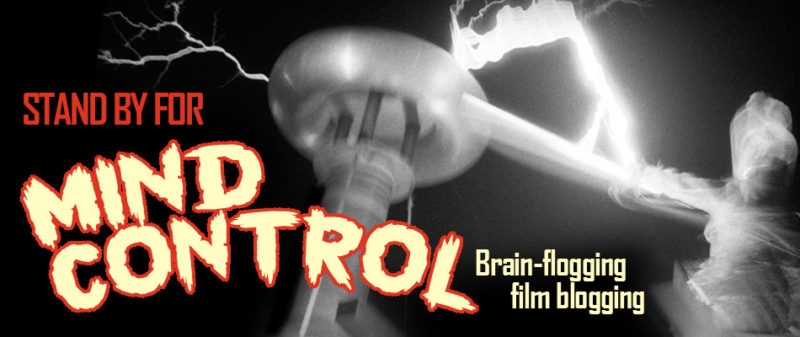
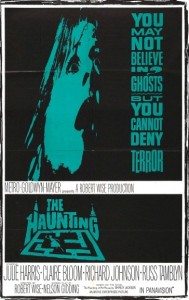
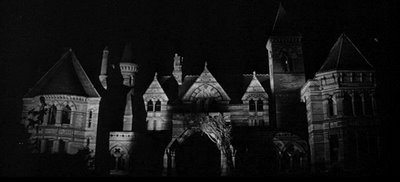
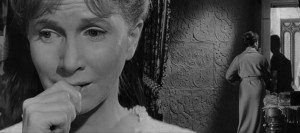
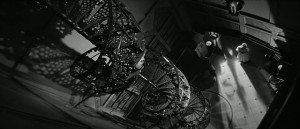
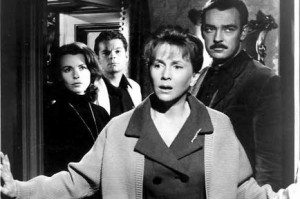
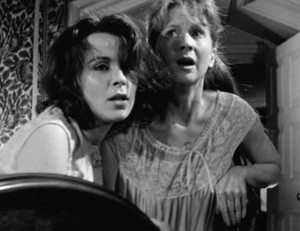
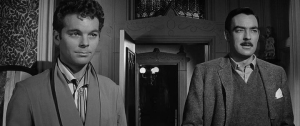
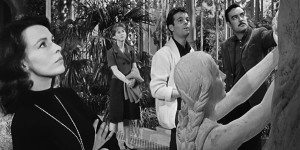
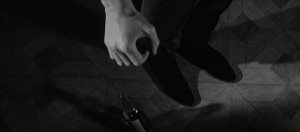
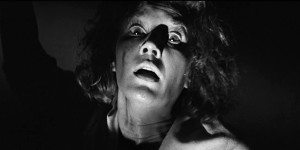
I’m confused. Is the driveway windy or windy?
Reviews such as this one are from people who solely rely on CGI and laid out explanations of the plot. I’m sure someone of a Star Wars
mentality would hate this movie!
You liked the film? Say why. Otherwise, you just sound petulant. And maybe watch your assumptions? It wouldn’t be hard at all to get a sense of what this author does and does not like. Something you have obviously not bothered to do.
You didn’t catch on this is the first true gay horror movie? The film is only superficially about a haunted house; the story is really about Nell’s repressed lesbian sexuality and Theo’s direct advances. They run to each other in the night, they almost kiss in bed when Nell is painting her toes, they hold each other sweaty in bed together while they feel the loud boom boom boom. When the love scene is finally interrupted by the fatherly Dr. Marquay, they giggle and say nothing happened, they had a great time. It’s about there that Theo tells Nell, “You’re wearing my robe”. Right? Don’t be thick. Nell can’t take her gay emotions and she tries to kill herself on the balcony, but the Doctor saves her from falling and holds her in his arms, ready to cheat on his wife right then and there, but Nell just can’t do it, she can’t fall for a man. Meanwhile every time Nell and Theo get together there are semi-erotic nude sculptures of women on the walls and tables around them. And of course, you can’t forget the statue that Theo stares at of two women in a pose that makes it appear that one is fondling the other’s breast – you can freeze frame it. Theo looks snarky whenever Marquay gets affectionate with Nell; she also puts the deep freeze on Luke right away. Nell becomes more and more conflicted about feelings for Theo and she starts to lose it. When even Theo tells Nell to leave, her broken her heart causes her to take her own life by driving her car into a tree. The first true gay horror movie, and the still the best in my opinion.
Well, this take certainly sounds better than the movie I watched 10 years ago. Should I watch it again, I will keep this in mind, and report back my findings. I can’t promise this will occur anytime sooner than, say, another 10 years, but now that I’m intriuged, one never knows…